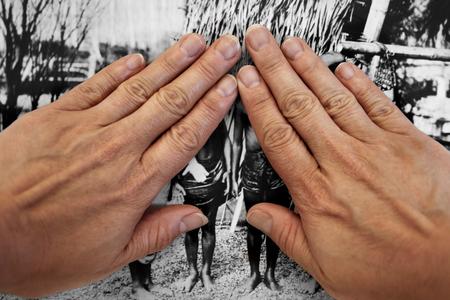“I won’t live that long,” Clinard shouted at the judge, according to a prosecutor’s court filing. “I don’t intend to live past another two weeks. You just signed my death warrant, bitch!” He then head-butted the guard who tried to escort him out of the courtroom and tried to grab the guard’s taser, adding an assault charge to his rap sheet.
Clinard, a photographer who was once a rising star on the local and national magazine scenes, made good on his threat in all but one particular. Three, not two, weeks later, fellow inmates told the deck officer overseeing the county jail’s eighth floor that Clinard was lying motionless on the floor of his unlocked cell. According to a Seattle Police Department investigation of the incident, the officer initially thought the inmates “were joking with him” and did not check on Clinard for six minutes. (However, that officer’s written statement and the King County Department of Adult and Juvenile Corrections’ own investigation stated that the officer responded in just one minute.)
Officers, medical staff and EMTs scrambled to save Clinard. They found a strip of cloth torn from a bedsheet around his neck; his face was swollen and purple, and blood pooled around him, apparently as a result of striking his head as he fell. They cut the cloth away, inserted an air tube, performed extended CPR, applied a defibrillator and gave him two epinephrine shots before finally giving up. Investigators declared his death a suicide.
Suicide is an occasional — good statistics on frequency are lacking — tragedy at the jail; psychological distress is an everyday fact of life. The King County Jail has long been described as the state’s “second-largest mental hospital” after Western State Hospital in Lakewood — except that the jail is hardly staffed or equipped to operate as a hospital. Its psychiatric unit, which serves both the Regional Justice Center in Kent and the downtown jail, has just 141 beds. King County Corrections recently identified 269 inmates (out of a total of 1,945 at the two facilities) suffering from serious mental illness. A county study several years ago found that a much larger share, about a quarter to a third, were receiving psychiatric care such as supervised medication.
This burden reflects a chronic shortfall in state resources for the mentally ill, even the resources to conduct something as basic as evaluations to determine whether arrested suspects are competent to stand trial. “More and more people with mental illness are in jail because of lack of community services,” says Kim Molsof, an attorney with the watchdog organization Disability Rights Washington.
According to the National Alliance on Mental Illness, people experience mental-health crises “are more likely to encounter police than get medical help,” and two million are booked into jails each year. Here in Washington, as in other states, jails wind up coping with government and society’s failures to meet the needs of the mentally ill: the failure to fund community health services after patients were cleared out of state hospitals in the 1960s and ’70s; the failure to provide housing for the needy; even Washington state’s failure to provide timely competency assessments to determine whether defendants are competent to stand trial and provide the treatment needed to stabilize them and restore competency.
A 2012 state law set a target of seven days (later increased to 14) for the state — in practice, Western State Hospital — to perform competency evaluations and take in inmates needing treatment. But a persistent backlog of these “psychiatric boarders” languishes in jailhouse limbo, sometimes waiting longer, the deputy director of the Public Defender Association told the Seattle Times, than they would spend in jail if they had been tried and sentenced. In 2014, the public defenders sued the state Department of Social and Health Services, charging that this psychiatric boarding violated detainees’ rights to due process and exacerbated their mental problems. In 2015 a federal judge agreed and began fining the state for failing to comply, racking up total penalties of $50 million. Disability Rights Washington has taken over the suit, now established as a class action and commonly known as the Trueblood case. It has become the mental-health equivalent of the McCleary decision on state education funding.
This year, Disability Rights Washington and partner groups worked out a plan to help counties establish diversion programs to bypass that logjam and provide mentally ill inmates other treatment. Thirteen programs are due to start up around the state this summer. Meanwhile, the logjam continues. Last month, at Crosscut’s request, King County crunched the numbers and found that 34 inmate patients had been waiting up to 186 days at the King County Jail for beds to open at Western State so they could receive restorative treatment.

Michael Clinard was hardly typical of the waves of dispossessed, chronically ill people who cycle between jail and the streets. He was a creative professional, gifted and accomplished though lately financially struggling, with a growing family, a house in the suburbs, a second professional base in New York, and no criminal record beyond traffic tickets and DUIs. He’d attended art school and worked as a photographer’s assistant, learning the craft until he broke out on his own in a feature story for Seattle Met in 2010. That story was a straightforward feature on yoga, but Clinard’s photos, showing practitioners performing their everyday tasks — feeding a photocopier, waiting tables — in gravity-defying poses, bore the hallmarks of his subsequent work: high-concept, highly staged tableaux of everyday life with a telling twist.
Clinard shot dozens more stories for Seattle Met. “I respected him and enjoyed working with him,” says the magazine’s art director, Jane Sherman. “The work we produced together really helped define where the magazine was going. He would enhance the concept for each story he worked on. Working with him could be intense because he would come up with a lot of ideas really fast.”
After a few years, Clinard priced himself out of the local market and began building a national portfolio. He shot the cover for Fortune’s 2015 “Fortune 500” issue with the “500” formed by the yellow wiring in a Microsoft cloud server bank in Quincy. For an Adweek feature on chicken’s ascent in the American diet, he shot a close-up of a chicken pecking at a hamburger. In a cover image for Huffington Magazine, a cougar tugs alarmingly at a girl’s teddy bear as her cellphone-distracted mother tugs her across a suburban crosswalk. Various photography blogs and magazines interviewed him. One lauded “the magical mind of Michael Clinard.”
For those closest to Clinard, however, that magic turned dark. In February 2017, his wife petitioned King County Superior Court for a protection order. In her filing, his wife recounted a harrowing, escalating ordeal of verbal abuse, raging outbursts and threats. She acknowledged to the court knowing that Clinard was a recovering alcoholic when they married, that a doctor had seen signs of bipolar disorder when he was in his teens, and that he had a quick temper, but said that by then “he had it mostly under control.” Then the birth of their daughter, who’s now 6, and of twins who are now toddlers brought new stresses, and he suffered a severe drinking relapse, the wife told the court.
Seattle Met’s Jane Sherman got a different impression of the family’s life from Clinard. “The first time we worked together he said he’d talked with his wife the night before about ideas for the feature, and I thought, ‘wow.’ It seemed like a cool relationship, that they talked like that. When they had their first kid, he seemed really excited. And when the twins were coming, he seemed even more excited. It seemed like his kids were everything to him.”
At the same time, his work also seemed to be everything. Sherman recalls how he would berate assistants he hired for shoots, railing “about kids these days not respecting the craft.” He could “be incredibly sweet and fun and funny, but there were a couple times when I felt like there was a switch that would flip. It was over the top, though not threatening.”
Clinard himself spoke with prescient, if unintended, irony about the challenges of trying to balance family and professional life in an interview posted on the blog This is the What in early 2014. “I’m a photographer, but equally, if not more importantly, I’m a father and husband,” he said then. “I feel that one’s personal life evolves at a pace that feels sometimes discordant or disproportionate to their professional life, and vice versa. In the end, all I can do is what I do: keep being.”
In December 2013, Clinard tangled with a group of teenagers outside a friend’s house in Brooklyn, New York. They beat him badly, leaving him with a broken knee and severe concussion, Clinard's wife recounted in her filing for a protection order that he was subsequently diagnosed with brain trauma, post-traumatic stress disorder and bipolar disorder. As she told it in the filing, the mood swings and rages grew much worse. Finally, in January 2017, one turned violent. He locked his legs around her throat, she recounted, and choked her in front of the kids. She sought protection and restraining orders and filed for divorce. Over the next four months, Clinard was charged with DUI and reckless driving and with violating those orders six times, which brought him back to court and to jail.
According to the police investigative report into his death, Clinard called his mother, Maria Clinard, from the jail on July 3, about an hour before he was found passed out and repeatedly told her that he was “done.” Maria Clinard, speaking from the family home in Athens, Alabama, recalls the conversation differently: “He called just to wish me ‘good night,’ and he told me, ‘Tomorrow’s Independence Day.’
“We used to celebrate Independence Day,” she explains; Michael would do the barbecuing. “He was a great cook.” Her voice becomes drawn. “He was well-regarded by everybody here.” But she said she found the call unsettling. “It didn’t sound like Michael,” she says. “I should have suspected something was wrong, but I thought he was in good hands.”
An hour later, her son would be found purple-faced and bleeding on the jailhouse floor.
“I hold the jail responsible,” she says.
Officials said they couldn't comment.
Inmate suicide is something the county works strenuously to prevent. Starting at intake, Jail Health Services, a division of the King County Department of Health that provides mental health services and other health care in the jail, maintains a multi-tiered series of screenings, evaluations and assignment protocols intended to sift out inmates at risk and funnel them to the right care and oversight. Corrections and medical staff alike are supposed to be trained in suicide prevention. Somehow, Michael Clinard slipped through the screens.
The process, spelled out in a suite of Jail Health Services policies, procedures and forms, starts even before inmates are booked into the jail. When police deliver a new inmate, corrections officers perform a brief “deferral screening.” If they find any of 26 listed physical conditions — from bleeding and shakes to diabetes and pregnancy — or observe “severely agitated/irrational behavior,” they are directed to call in a registered nurse, who will decide whether to “defer” the inmate to a hospital. They also ask whether the inmate is “suicidal now” or has attempted suicide in the past 12 months, and whether the transport officers heard any suicide talk on the way down.
The deferral screening form filled out for Clinard shows that when Bothell police officers delivered him to the downtown jail on June 12, they passed along word of his outburst to the judge just an hour or so earlier. An intake officer noted this with minimizing detachment — “Suicidal statements were made in court today” — but also noted that Clinard was not suicidal now and had not tried to kill himself in the past year.
Even that minimal note should have raised a red flag, say experts familiar with jail mental-health screening and treatment procedures. Any indication of suicidal intent is supposed to be enough to send inmates to a psychiatric unit, where they will be monitored every 15 minutes or less — constantly, if they’re deemed at acute risk — and receive close evaluation and treatment. Often merely unburdening themselves in that evaluation lifts the cloud and dissipates suicidal intentions, says one expert who asked not to be named.
“The protocol is that anyone who says they are suicidal or engages in self-harm behavior will be placed on suicide watch,” says Nancy Whitney, mental health director at the South Correctional Entity (SCORE), a privately operated 600-bed jail near Seatac that serves several local municipalities. The exception, says Whitney, is inmates who are “detoxing and just miserable” and moan that they wish they were dead; they get detox treatment instead. Even when medical staff suspect inmates are faking suicidal intent to get meds, they put them on suicide watch, she adds. “You don’t want them to escalate by harming themselves. You don’t want them to take a dive off the stairs to get opiates.”
Likewise at the King County Jail, says Disability Rights Washington attorney Molsof: “I think the jail errs on the side of caution. Even when an inmate makes a comment and then says, ‘I take it back,’ they tend to put them on close watch.” Still, she notes, “no system is perfect.”
Following booking, Clinard would have undergone a more extensive screening by an intake nurse, who would have reviewed his deferral screening and medical records and checked for other risk factors, such as suicidal ideation and recent psychiatric treatment. That screening’s exact findings are shielded by health-privacy law, pending consent to their release by next of kin. But it clearly did not identify him as a suicide risk.
King County Health officials say they cannot comment on Clinard’s case because of that law. But their spokesman James Apa did provide this general statement: “Our jail health care providers and support staff are saddened anytime someone loses their life while in our care. We constantly work to provide a high standard of care for people in the jail facing a wide variety of physical and behavioral health needs, including those suffering from mental distress.
“We have strong protocols for suicide prevention and continually train to them, both for Jail Health and Department of Adult and Juvenile Detention staff.”
Despite those protocols, Clinard’s violent, vehement vow to take his own life fell off the radar. He was placed in the jail’s general population rather than in its seventh-floor psych unit.
And so he brooded and bided his time. And then he did just what he said he was going to do.
Crosscut is choosing not to name Michael Clinard's wife because she was a victim of domestic violence.



